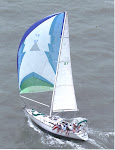The linear after it was serviced but before reinstallation
The
Simrad-Robertson AP32 autopilot was the longest lived piece of
electronics on the White Pepper. It
had given also 20 years of faithful service. About 6 years ago it had
begun to leak slowly. Upon the advice of Simrad I added several
ounces of West Marine hydraulic fluid to the reservoir and things
seemed to work. Yes, West Marine brand of hydraulic fluid was
specifically recommended by Simrad. I would have to add about two
onces of fluid per year.
Last
year the control unit refused to response. It was time for a
replacement. I bought a new Garmin 722 chart plotter, a Garmin 40
Reactor autopilot and appropriate connectors The unit was
professionally installed by a marine electrician in St. Augustine,
FL.
.
One
piece of equipment that I chose not to replace was the Robertson
hydraulic linear drive which seemed to be working, albeit leaking.
The autopilot passed its sea trail in St. Augustine and seemed to be
working fine. Then it failed suddenly on the Mosquito Lagoon just
south of New Smyrna and two days south of St. Augustine.
The
linear drive was clearly hemorrhaging fluid. The choice was between
buying a new one or servicing the old one. Plus we were in Vero
Beach, and I could not find anyone interested in doing this kind of
work. As dreadfully difficult as it was to remove the linear drive
from the cramped confines of the stern, mounting a new unit seemed
even more daunting. It took all of one morning to unscrew the 4
bolts holding the unit to the mounting stage. I had to take off the
scupper hose to get to the rudder post and unscrew the ram. Later it
became obvious that I could have just pulled a pin rather than
unscrew the whole thing.
Here
I have to confess that I did not service the unit myself. It is no
longer made or supported. Simrad has been sold to Navico. There are
no readily available seal kits on the internet, and I would not know
how to replace the seals anyway.
I
took the unit to Verohydraulics in Very Beach, Florida, who assured me that this was a
routine matter. They did have some difficulty obtaining a seal kit.
However, after a week it was ready and did not seem to leak on the counter.
Remounting
the unit was as difficult as removing it. It weighs 40 pounds and
only an outstretched left arm was available to wrestle it around. After it was finally
screwed back in there were two subtle points that could be useful to
the interested reader. The action of the rudder was quite rough.
However, if the cap to the reservoir was removed and the wheel moved
back and forth then numerous air bubbles were forced to the surface
. The action became much smoother.
Secondly the mounting stage was found to be loose. This could not be a
surprise after 20 years. Some washers were added and the screws
attaching the stage to the hull were tightened. I suspect that this
looseness and shock loading to the ram probably contributed to the
overall problems. I'll bet that this may be a hidden problem on many
boats.
Repeat sea trials are next to see if servicing the sturdy old Robertson HLD2000 is enough to restore the autopilot.
Now for the rest of the story. The autopilot failed the sea trial and never even got past the rudder calibration. We had to hand steer all the way to Miami from Fort Pierce. In Miami on the suggestion of Garmin support I called for help from Langer Kwell Electronics. They sent out a cracker jack technician, Joe. He tried every trick in his bag to get the unit to respond without success. It was also empty of fluid (thanks for nothing Verohydralauics). After several expensive hours it became clear that only a new hydraulic drive would do. I can't complain too much. The unit gave 20+ years of excellent before it just wore out.
So I guess that the take home lesson for anyone reading this post in order to learn about the Robertson 2000 is to probably buy a new linear drive.
Repeat sea trials are next to see if servicing the sturdy old Robertson HLD2000 is enough to restore the autopilot.
Now for the rest of the story. The autopilot failed the sea trial and never even got past the rudder calibration. We had to hand steer all the way to Miami from Fort Pierce. In Miami on the suggestion of Garmin support I called for help from Langer Kwell Electronics. They sent out a cracker jack technician, Joe. He tried every trick in his bag to get the unit to respond without success. It was also empty of fluid (thanks for nothing Verohydralauics). After several expensive hours it became clear that only a new hydraulic drive would do. I can't complain too much. The unit gave 20+ years of excellent before it just wore out.
So I guess that the take home lesson for anyone reading this post in order to learn about the Robertson 2000 is to probably buy a new linear drive.


No comments:
Post a Comment